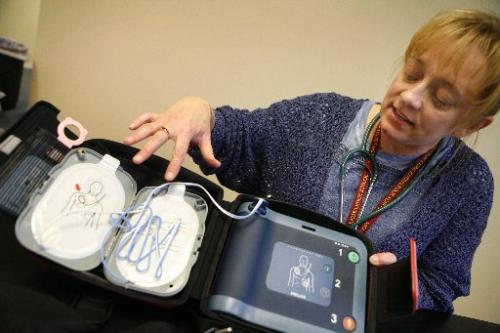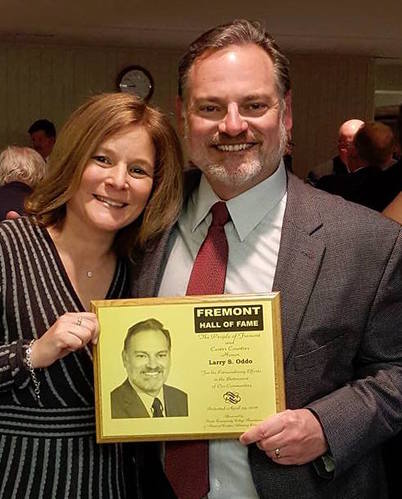Echoes from Cañon
Examples of Excellence

The week of May 1st through May 7th is National Teacher Appreciation Week as proclaimed by President Barack Obama, and I want to take a moment to thank our wonderful Cañon City Schools teachers for all they do to improve the lives of the children in their care. What better way to celebrate examples of excellence! As President Obama stated in his proclamation, “Just as we know a student's circumstances do not dictate his or her potential, we know that having an effective teacher is the most important in-school factor for student success.” I wholeheartedly agree with the president on this. Mr. Obama’s proclamation includes this language: by virtue of the authority vested in me by the Constitution and the laws of the United States, I hereby proclaim May 3, 2016, as National Teacher Appreciation Day and May 1 through May 7, 2016, as National Teacher Appreciation Week. I call upon students, parents, and all Americans to recognize the hard work and dedication of our Nation's teachers and to observe this day and this week by supporting teachers through appropriate activities, events, and programs.
 MVCKS Nurse Jody Enderle's work was highlighted this week by the Colorado League of Charter Schools.
MVCKS Nurse Jody Enderle's work was highlighted this week by the Colorado League of Charter Schools.
Last week we received news that our Mountain View Core Knowledge School was featured in this month’s Colorado League of Charter Schools newsletter for outstanding work in the realm of school health. MVCKS was lauded for employing a school nurse, despite its small size. The author said, “The school’s leadership and the nurse herself agree that students cannot learn if they are not healthy.” Jody Enderle is this nurse, and she supports staff, students and families so they may be the healthiest they can be. She assists teachers develop IEPs and 504 plans for students. She manages critical care and health care plans for children with varying conditions such as allergies, asthma, and diabetes. Jody provides all training to teachers for medication administration, and maintains all health records. She also conducts vision and hearing screenings and checks students for warning signs of diabetes. Jody even provides flu shots to staff members on site at the school, and instruction to students at all grade levels aligned to the Colorado Comprehensive PE and Health Standards. This ranges from learning about personal hygiene and germs, to body parts, safety, nutrition education, healthy choices, and sex education. Thank you so much Jody, for all you do to support our students in this manner!
Finally, this Friday Cañon City Schools board of education president Larry Oddo was honored with induction into Pueblo Community College-Fremont Campus Hall of Fame. Mr. Oddo received this recognition as a result of his involvement on many local boards and in numerous area organizations. Through his business activities at the Holy Cross Abbey Winery, and dedicated personal involvement, Mr. Oddo has helped grow many of Cañon City’s tourism programs, and has been a staunch supporter of the educational programs offered thorough PCC, and of course through the Cañon City School District. Congratulations Mr. Oddo, and thank you for your continued involvement and your dedication to the improvement of opportunities for our people and our local economy!
Finally, this Friday Cañon City Schools board of education president Larry Oddo was honored with induction into Pueblo Community College-Fremont Campus Hall of Fame. Mr. Oddo received this recognition as a result of his involvement on many local boards and in numerous area organizations. Through his business activities at the Holy Cross Abbey Winery, and dedicated personal involvement, Mr. Oddo has helped grow many of Cañon City’s tourism programs, and has been a staunch supporter of the educational programs offered thorough PCC, and of course through the Cañon City School District. Congratulations Mr. Oddo, and thank you for your continued involvement and your dedication to the improvement of opportunities for our people and our local economy!
The Focus of Our Work
 CCSD Board president Larry Oddo, shown with his wife Diane, was indicted into the PCC-Fremont Campus Hall of Fame on Friday.
CCSD Board president Larry Oddo, shown with his wife Diane, was indicted into the PCC-Fremont Campus Hall of Fame on Friday.
We had a pretty good early part of the week as we received news from the Colorado Department of Eduction that we will receive a three year Early Literacy Grant totaling $500,000, as well as a four year Colorado Counselor Corps Grant totaling just a little over $300,000. We also met with a Colorado Health Foundation representative about the possibility that we will be recommended to receive a 2 year grant for more than $600,000 to support work being done by our regional Health and Wellness committee. We also completed work this week on a school health professionals grant application that would bring additional nursing, psychologist, and mental health counseling services to our children in need.
On Monday the board of education heard a report from the middle school math materials adoption committee regarding their recommendation to purchase enVision math resources for next year. After additional research and consideration the board will take official action on this recommendation at its May 9th meeting.
The district is moving forward on candidate searches for a new director of special services and a replacement principal for Cañon City High School. On Monday we’ll conduct application screening processes in hopes of setting up interviews to take place during the 2nd week of May.
Once again this past week the Cañon City Education Association and the Cañon City School District negotiated updated master agreement language. Last Wednesday we reviewed suggested clean up language from a task force, and discussed story, interests, and options related to which professional development days should be guided by the district and which should be driven at the building level. Subcommittees will develop straw designs related to these options in preparation for continuing work the issue next Wednesday.
On Monday the board of education heard a report from the middle school math materials adoption committee regarding their recommendation to purchase enVision math resources for next year. After additional research and consideration the board will take official action on this recommendation at its May 9th meeting.
The district is moving forward on candidate searches for a new director of special services and a replacement principal for Cañon City High School. On Monday we’ll conduct application screening processes in hopes of setting up interviews to take place during the 2nd week of May.
Once again this past week the Cañon City Education Association and the Cañon City School District negotiated updated master agreement language. Last Wednesday we reviewed suggested clean up language from a task force, and discussed story, interests, and options related to which professional development days should be guided by the district and which should be driven at the building level. Subcommittees will develop straw designs related to these options in preparation for continuing work the issue next Wednesday.
Last Week
 On Thursday I had the pleasure of judging 15 chili recipes with Harrison principal John Pavlicek.
On Thursday I had the pleasure of judging 15 chili recipes with Harrison principal John Pavlicek.
On Monday morning I had a series of parent and staff member meetings. During the afternoon I participated in a Colorado Health Foundation site visit related to a grant application we submitted, a school board work session, and a regular board meeting. On Tuesday I attended high school building leadership team, superintendent advisory council, and district leadership team meetings, and I poked in to observe a digital citizenship presentation by a district level committee that took place at Mckinley Elementary School. On Wednesday Morning I attended the Southern Superintendent’s meeting in Pueblo, and then presented a program on school finance to the Cañon City Rotary Club. In the afternoon I attended a technology committee meeting at Lincoln School of Science and Technology, and then master agreement negotiations until 7 PM. On Thursday I participated in CCEOE scholarship interviews and judged chili recipes at the Mountain View Core Knowledge School Spanish Festival along with Harrison principal John Pavlicek. I worked in my office on Friday morning, had a working lunch with board president Larry Oddo, attended a Snap-On-Tools presentation at the CCHS Vocational Automotive classroom, and attended the Pueblo Community College Hall of Fame Dinner with all of our board members.
This Week
 Last week I had the pleasure of observing a presentation on how to use a voltage meter in our concurrent enrollment vocational automotive class.
Last week I had the pleasure of observing a presentation on how to use a voltage meter in our concurrent enrollment vocational automotive class.
Early Monday morning I will meet with director of student services Dominic Carochi and representatives from Lindamood-Bell to plan for implementation of our Early Literacy Grant. Throughout the day I will participate in applicant screening committees for our open director of special services and high school principal positions. On Monday evening I will attend a regional health and wellness committee gathering, and the Heartbeat Suicide Awareness session at St. Thomas More Hospital. On Tuesday I will be on KRLN Morning Line at 8:30 AM, and will then work in my office preparing for high school principal interviews and revising our Counselor Corps grant application for the remainder of the day. On Wednesday we have a district administration team meeting first thing in the morning, and master agreement negotiations in the afternoon and evening. On Thursday and Friday I will be in the Denver area to attend a statewide pathways conference in Aurora, and to participate in work being driven by former state treasurer Cary Kennedy related to improving K-12 education in Colorado.
The Way I See It

During the past several weeks I have discussed major education funding issues in Colorado. I covered how schools are funded, where Colorado ranks nationally in funding, the affects of inadequate funding on the Cañon City School District, and the constitutional tug of war that has resulted in limited state revenues leading to difficulties when it comes to adequately funding K-12 education programs.
As a result of per pupil education funding in Colorado dipping below the national average, many attempts have been made to address the problem. However, I believe our funding problems had been identified as far back as 1982 when the Lujan case related to funding inequities, based on variances in local property wealth, hit the Colorado Supreme Court. As a harbinger to all future cases, Colorado's high court sided with the state at that time saying the plaintiffs did not even have the right to sue over a matter such as this.
Following the failure of Lujan the next target was not operations dollars, but rather how school construction projects are funded. In 1998 the Giardino lawsuit was filed to support school districts that have low property value in raising dollars to construct new buildings or repair old ones. After several days in court the state of Colorado actually requested to settle the matter, agreeing to pump almost 200 million dollars into a statewide capital construction fund. However, it was soon recognized this dollar amount would not offer an effective long term solution, so by 2008 the legislature developed a program called Building Excellent Schools Today. BEST created a competitive grant process, funded by state land trust revenues, that has since funded the construction of many new schools and remodeled countless others so long as school districts can offer up a required cash match. Cañon City Schools has benefited from this grant process by tapping into funds to upgrade safety alarms. This year we have even asked for BEST support to repair some of our aging roofs.
In 2005 a number of school districts and parents filed a lawsuit against the state of Colorado that came to be known as the Lobato case. After a first trip through the Colorado Supreme Court to simply garner the right to have its day in court, an actual trial was held in August 2011 where the judge ruled Colorado schools were being underfunded by nearly 4 billion dollars. However, following a two year appeals process Colorado’s high court overruled that trial judge’s decision on a 4-2 vote, thereby maintaining the status quo when it comes to education funding.
Lobato v Colorado led to two other attempts to solve our K-12 funding problems. In 2011 Boulder area politician and former gubernatorial candidate Rollie Heath was able to get Proposition 103 on the statewide ballot. Prop 103 would have addressed some of the problems identified in the Lobato lawsuit. However, it failed by a 65 to 35 percent margin statewide.
After the Supreme Court overturned the Lobato trial verdict in May 2013 Governor Hickenlooper and the state legislature passed a legislative measure aimed at making the school finance act more equitable. However, to do this 1 billion dollars of additional funding was needed and this was presented as a question to Colorado voters in the form of Amendment 66. This measure lost by a 66 to 34 percent margin in November 2013, on the same ballot Cañon City School District bond and mil levy questions were defeated by very small margins.
Along the way Colorado voters legalized recreational use of marijuana with a promise to fund education through tax dollars collected. Where do those dollars actually go and how many are allocated? Only 40 million dollars of annual marijuana tax revenues are actually passed on to schools each year, and all of them go to the BEST competitive grant process. Another way to look at this is 40 million dollars per year might be enough to build one school per that houses around 1,000 students, per year. With Judge Rapport declaring back in 2011 that Colorado underfunds its K-12 school system by 4 billion dollars per year, it is quite clear that marijuana tax dollars have not been the answer to education funding woes many people hoped for.
The summer of 2015 brought about one final opportunity for Colorado’s high court to do right by its K-12 students. The Dwyer case asked the Court to declare the establishment of the negative funding factor unconstitutional, a violation of the original voter intent of Amendment 23. Amendment 23, which passed after the Taxpayer Bill of Rights (TABOR), was designed to increase base K-12 funding, as well as funding of various school finance factors, by minimum at the rate of inflation on an annual basis. However, the invention of the negative factor removed school finance act factors (such as size, poverty rate, cost of living factors) from this formula and allowed the state to actually reduce funding by nearly 1 billion dollars per year during the Great Recession, when for all intents and purposes Amendment 23 was passed to increase it. A 4-3 vote against the plaintiffs once again left Colorado’s school finance system as it currently stands, by many measures woefully inadequate when it comes to providing the basic resources needed to educate our children to an acceptable level.
Next week I will share information on statewide efforts being made this fall when it comes to solving our state’s education finance issues. In two weeks I will share what I think our only true solution is.
Thanks for listening once again!
George S. Welsh
As a result of per pupil education funding in Colorado dipping below the national average, many attempts have been made to address the problem. However, I believe our funding problems had been identified as far back as 1982 when the Lujan case related to funding inequities, based on variances in local property wealth, hit the Colorado Supreme Court. As a harbinger to all future cases, Colorado's high court sided with the state at that time saying the plaintiffs did not even have the right to sue over a matter such as this.
Following the failure of Lujan the next target was not operations dollars, but rather how school construction projects are funded. In 1998 the Giardino lawsuit was filed to support school districts that have low property value in raising dollars to construct new buildings or repair old ones. After several days in court the state of Colorado actually requested to settle the matter, agreeing to pump almost 200 million dollars into a statewide capital construction fund. However, it was soon recognized this dollar amount would not offer an effective long term solution, so by 2008 the legislature developed a program called Building Excellent Schools Today. BEST created a competitive grant process, funded by state land trust revenues, that has since funded the construction of many new schools and remodeled countless others so long as school districts can offer up a required cash match. Cañon City Schools has benefited from this grant process by tapping into funds to upgrade safety alarms. This year we have even asked for BEST support to repair some of our aging roofs.
In 2005 a number of school districts and parents filed a lawsuit against the state of Colorado that came to be known as the Lobato case. After a first trip through the Colorado Supreme Court to simply garner the right to have its day in court, an actual trial was held in August 2011 where the judge ruled Colorado schools were being underfunded by nearly 4 billion dollars. However, following a two year appeals process Colorado’s high court overruled that trial judge’s decision on a 4-2 vote, thereby maintaining the status quo when it comes to education funding.
Lobato v Colorado led to two other attempts to solve our K-12 funding problems. In 2011 Boulder area politician and former gubernatorial candidate Rollie Heath was able to get Proposition 103 on the statewide ballot. Prop 103 would have addressed some of the problems identified in the Lobato lawsuit. However, it failed by a 65 to 35 percent margin statewide.
After the Supreme Court overturned the Lobato trial verdict in May 2013 Governor Hickenlooper and the state legislature passed a legislative measure aimed at making the school finance act more equitable. However, to do this 1 billion dollars of additional funding was needed and this was presented as a question to Colorado voters in the form of Amendment 66. This measure lost by a 66 to 34 percent margin in November 2013, on the same ballot Cañon City School District bond and mil levy questions were defeated by very small margins.
Along the way Colorado voters legalized recreational use of marijuana with a promise to fund education through tax dollars collected. Where do those dollars actually go and how many are allocated? Only 40 million dollars of annual marijuana tax revenues are actually passed on to schools each year, and all of them go to the BEST competitive grant process. Another way to look at this is 40 million dollars per year might be enough to build one school per that houses around 1,000 students, per year. With Judge Rapport declaring back in 2011 that Colorado underfunds its K-12 school system by 4 billion dollars per year, it is quite clear that marijuana tax dollars have not been the answer to education funding woes many people hoped for.
The summer of 2015 brought about one final opportunity for Colorado’s high court to do right by its K-12 students. The Dwyer case asked the Court to declare the establishment of the negative funding factor unconstitutional, a violation of the original voter intent of Amendment 23. Amendment 23, which passed after the Taxpayer Bill of Rights (TABOR), was designed to increase base K-12 funding, as well as funding of various school finance factors, by minimum at the rate of inflation on an annual basis. However, the invention of the negative factor removed school finance act factors (such as size, poverty rate, cost of living factors) from this formula and allowed the state to actually reduce funding by nearly 1 billion dollars per year during the Great Recession, when for all intents and purposes Amendment 23 was passed to increase it. A 4-3 vote against the plaintiffs once again left Colorado’s school finance system as it currently stands, by many measures woefully inadequate when it comes to providing the basic resources needed to educate our children to an acceptable level.
Next week I will share information on statewide efforts being made this fall when it comes to solving our state’s education finance issues. In two weeks I will share what I think our only true solution is.
Thanks for listening once again!
George S. Welsh
